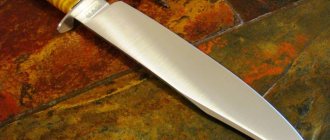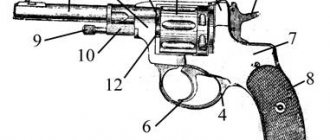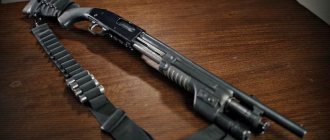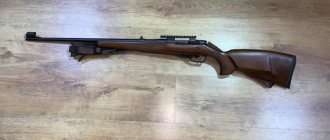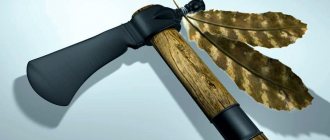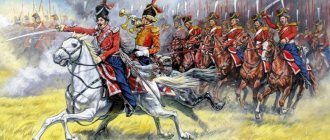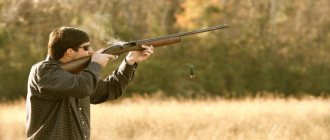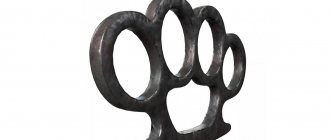All traditional Chinese swords can be divided into two main types: jian (劍) and dao (刀). Jian is a double-edged straight sword, while dao is single-edged and mostly curved, produced since the Song Dynasty. The term "jian" was sometimes translated as "long sword" and "dao" as "saber" or "knife".
Bronze jian appeared from the middle of the third century BC. These swords began to be forged from iron and steel around the time of the late Warring States Period. Apart from specialized weapons such as the "split dao", Chinese swords are typically 70–110 cm in length, although longer examples are occasionally found.
Outside of China, Chinese swords were also used from the third to sixth centuries AD. in Japan (subsequently, since the Middle Heian era, Chinese swords were gradually replaced by Korean variations or local Japanese nihonto)
Warring States Period (475-221 BC)
Iron and steel swords ranging from 80 to 100 cm in length appeared in the middle of the Warring States Period in the kingdoms of Chu, Han and Yan. Most weapons were still made of bronze, but iron and steel weapons were already being produced in increasing numbers. By the end of the 3rd century BC, the Chinese had learned to produce hardened steel swords, and from that time on, bronze weapons fell completely out of use.
The ancient Chinese text Zhanguo Tse (Strategies of the Warring States) states that the Han kingdom produced the best weapons that were capable of piercing the strongest armor, shields, leather boots and helmets.
Secret weapon
0
A secret weapon is a weapon that is carried hidden and used unexpectedly by the enemy. A classic Chinese secret weapon is the biao dart. This word even gave birth to all terms related to security: caravan guard - biaoke, caravan security bureau - biaoju, etc. The dart was made of steel, had a triangular tip, was about 12 cm long and weighed 100 g. A dart weighing half a kilogram was called a “golden dart.” There were two ways to throw a dart - with a direct grip and with a reverse grip. Another type of secret weapon is the Xiujian sleeve arrow. They were loaded into round tubes placed in the sleeves, which contained a firing mechanism. One press of the button and the arrow flew out. The length of the tube is about 20cm, the length of the arrow is about 15cm. Although these two types of secret weapons are similar in many ways, the use of sleeve arrows requires much less force, the range of the shot depends entirely on the power of the spring. The range of throwing a dart depends entirely on the amount of wrist force. Both types of weapons must hit the target accurately, so using a dart is much more difficult than using sleeve arrows. That is why the saying “a hundred days for sleeve arrows, a thousand days for darts-biao” was born.
Han Dynasty (206 BC – 220 AD)
Jian was mentioned in the list of "five weapons" during the Han Dynasty, the other four being dao, spear, halberd and staff. Another version of the "five weapons" also includes the bow and crossbow (as one weapon), as well as the jian and dao (as one weapon), in addition to the halberd, shield and armor.
The jian was a popular weapon during the Han era, where a class of swordsmen emerged who made their living from swordsmanship. Sword fencing was also a popular pastime for aristocrats. It is known that there was a group of noble people, consisting of 37 people, known as the "Way of Jian". According to evidence from those times, the best swordsmen were in Southern and Central China.
There was a sword called the “horse decapitating jian”; this weapon was called that because it could supposedly be used to cut off a horse’s head. However, another source says that it was not a military weapon, but an execution instrument used on special occasions.
Dao with a ring pommel became widespread in the Han era, primarily as a weapon for cavalry. The main advantage of the Dao was that it was a single-edged weapon, so the back side of the blade could be expanded and made thicker for strengthening. This design feature makes the Dao a more reliable sword for combat. Combined with a shield, the increasingly popular dao practically replaces jian. It is mentioned that after the Han Dynasty, sword dancing began to be performed using dao rather than jian. Archaeological specimens range from 86 to 114 cm in length.
An account of Duan Jiong's tactical formation in 167 AD states that this commander organized "... three ranks of halberdiers (鏃鏃 changzu), swordsmen (利刃 liren) and spearmen (長矛 changmao), supported by crossbowmen (強弩 qiangnu) and light cavalry (輕騎 jingji) on each flank.
Medium-range ballistic missiles
Chinese scientists recently developed a new anti-ship ballistic missile, the DF-26, a new model from the Dongfeng series of missiles that China has been using for many years. It is also called the "Beijing Killer Carrier". The DF-26 can conduct land and sea attacks at both medium and long range.
This weapon is designed for strategic intimidation, given the fact that it has a range of 4000 km! It is worth noting that American intelligence agencies have very little information about the development of this missile, which is why it poses a great threat to security in the Pacific region.
Northern and Southern Dynasties (420 - 589)
In the 6th century, craftsmen from the Northern Qi (the dynasty that ruled northern China) introduced Kim Huaiwen to a special process for producing steel using the "fusion" method, in which metal with varying carbon contents was used to produce steel. Based on evidence, daos made by this method were capable of breaking through 30 lamellar plates. It is not entirely clear from the description whether they meant iron plates or leather ones.
Huaiwen made sabers [dao 刀] from “midnight iron” [su 宿鐵]. His method involved annealing powdered cast iron with layers of soft (iron) blanks (ding 鋌, presumably thin plates). After a few days, the result was carbon steel (剛). Soft iron was used for the back of the saber. Huaiwen washed it in the urine of five sacrificial animals and tempered it in the fat of five sacrificial animals. A saber made of such steel could pierce thirty lamellar armor [zha 札], "Night soft blanks" cast today (in the Sui period) by the metallurgists of Xiangguo (襄國), represent a relic of technology (Kim Huaiwen). The sabers that are produced using this technique are still extremely sharp, but they cannot pierce thirty lamellar plates.
Xian Y-20 strategic transport aircraft
Better known as the "Plump Girl" by Chinese aircraft designers (due to its wide fuselage compared to other aircraft), the Xian 20 is a military cargo aircraft. His official codename is "Kumpeng", given to him after a bird from Chinese mythology. According to sources from Beijing, the Chinese leadership plans to design a new aircraft comparable in size to the legendary Soviet Mriya.
The 200-ton vessel is capable of flying non-stop to Europe, Australia and North Africa. China also wants to build another aircraft, equal in size to the largest passenger Airbus A380
Tang Dynasty (618 - 907)
During the Tang Dynasty, dao was divided into four categories. These were: ceremonial tao, protective tao, cross dao and separate tao. Ceremonial daos were the equipment of courtiers and were usually decorated with gold and silver. These weapons were also known as "imperial swords". The “protective tao” did not have any special specifics; in general, their name itself describes them. “Cross Dao” was mainly worn on the belt, hence its old name – “waist dao”. These swords were often used by crossbowmen as additional weapons. The "Split Dao", also called the "Long Dao", was a cross between an ancient sword and a saber. This type of weapon consisted of a 91 cm blade attached to a long 120 cm handle ending in an iron knob. Exceptionally large specimens with a total length of up to 3 meters and weighing up to 10 kg were also mentioned. Separate daos were used by the elite vanguard forces of the Tang era for the first attack.
There are 12,500 officers and soldiers in one army. Ten thousand people in eight sections with belt dao; two thousand five hundred people in two sections with separate dao. — Taibai Yinjing
Aircraft carrier CV-17
The CV-17 is China's very first aircraft carrier, which is nearing completion. Satellite photos hint that the carriers are unlikely to be used until 2022. In turn, CV-16 was a Soviet aircraft carrier purchased by the Chinese with the aim of opening a casino on board. Due to the system's imperfections, the ship's ability to detect threats on land and at sea is severely limited.
This aircraft carrier is capable of transporting about 48 aircraft and 12 helicopters. Its carrying capacity is 60-70 thousand tons. The CV-17 will be an improved version of the CV-16, but it will take several years of conversion and testing before it hits the water.
Ming Dynasty (1368-1644)
Dao continues to serve as the main melee weapon. During the Ming Dynasty, the jian again lost popularity, but this sword was still used by a limited number of specialists. Otherwise, this sword becomes famous for its quality and acts as a marker of scientific sophistication.
The Tao of the Horse Beheader was described in Ming Dynasty sources as a 96-centimeter blade attached to a 128-centimeter shaft, essentially a weapon similar to a glaive. It is assumed that the Swede Frederic Coyette was talking about this weapon when he described the troops of Zheng Chenggong wielding “a two-handed formidable battle sword attached to a stick equal to half the height of a man.”
Some were armed with bows and arrows hanging from their backs; others had nothing but a shield on their left hand and a good sword in their right hand; while many held in both hands a formidable war-sword, attached to a stick half the height of a man. All were protected in the upper part of the body by means of iron scales, covering each other like the slates of a roof; arms and legs remained bare. This provided complete protection from bullets and at the same time left enough freedom for movement, since their clothing reached only to the knees and was very flexible in all joints. Archers formed the best troops of Koxinga, and much depended on arrow support, because even at a distance, arrow throwers were able to handle their weapons with such skill that they were almost superior to firearms marksmen. Shield bearers were used instead of cavalry. Every tenth of them is a leader who took responsibility for his people and forced them to break into the ranks of the enemy. With their heads bowed and their bodies hidden behind their shields, they tried to break through the enemy's ranks with such fury and fearless courage as if each of them had another spare body. They constantly strive forward, despite the fact that many of them are knocked down; without stopping to think, they always rush into battle like mad dogs, without even looking back to see whether their comrades are accompanied or not. Those who have "sword sticks", which the Dutch call "soap knives", perform the same functions as our spearmen in preventing enemy breakthroughs. Thus, perfect order is established in the ranks; when the ranks of the enemy are in disarray, the swordsmen rush forward and pursue the retreating ones. — Frédéric Coyette
Qi Jiguang used a 12-man "tangerine duck" formation, which included: four pikemen, two warriors armed with dao with a large and small shield, two wolf brush wielders, a rearguard officer, and a porter.
Flexible weapon
0
This category includes multi-section steel bian whips, as well as liuxinchui (“meteor hammer” - a weight on a long rope), whip, shenbiao (“dart on a rope” - a spear point at the end of a long rope), feizhua (“flying claws” ") and so on. What they all have in common is the presence of a long flexible part. Weapons such as the multi-section whip are still popular in wushu today. They consist of a handle (about the width of the palm of your hand), several steel sticks connected to each other like a chain, and an end part (either made in the shape of a spear point or sharpened like a knife). The most standard is the nine-section jiujiebian whip, but seven-section and thirteen-section ones are also used. The attack was carried out with whipping blows, the defense was carried out by repulsing to the side with the help of a whip on the attacking object, or by defensive rotation. There are two types of whip fighting schools: those where most techniques are performed while standing (in which case most whip spins are performed in a vertical plane), and those where the techniques are performed while falling to the ground (in which case most whip rotations are performed in a horizontal plane). plane).
0
Shenbiao was used by caravan guards, who needed (in the event of an attack on the protected cargo) to quickly kill as many attackers as possible at the longest distance. The spear point was thrown like a dart, and with the help of a rope it was returned back. In this case, throwing did not take place from the hand, but with the help of preliminary unwinding of the tip on the rope like a sling.
0
Liu Xing Chui is actually a flail. Was especially good for pursuing a fleeing enemy. Flexible weapons are considered the most difficult to master, and therefore today, when edged weapons have lost their importance for self-defense, few people train in using them. The most important element in mastering a flexible weapon is the art of quickly winding and reeling it onto various well-timed body parts. This makes it possible to quickly change the radius of destruction, the speed of the warhead, and unexpectedly change the direction of movement.
Types of Chinese swords
Butterfly swords
(蝴蝶双刀; 蝴蝶雙刀; húdié shuāng dāo), sometimes called butterfly knives, are weapons native to southern China, although they were also used in the north. Typically used in pairs, they have a short dao (single-edged blade) that is approximately the length of a forearm. This makes it easy to hide this weapon in sleeves or boots. In addition, its small size allows for greater maneuverability during rotations and greater effectiveness in close quarters combat.
Changdao (Ming Dynasty)
(长刀; 長刀; "long knife") was a type of cavalry sword used in China during the Ming Dynasty. Sometimes also called "miao dao" (a similar but newer weapon), the blade is very similar in shape to the Japanese odachi.
Dadao
Dadao (大刀) (literally "big knife"), a type of dao or Chinese saber, is also known as the "Chinese big sword". The design is based on early agricultural knives. Dadao have wide blades, usually 60 - 90 cm long, long hilts, designed for use with one or two hands, and, as a rule, the balance in these swords is shifted towards the blade.
Shuangou
Shuangguo, an exotic Chinese weapon, is traditionally associated with northern styles of Chinese martial arts, but is now often practiced in southern styles.
Antler
This specific edged weapon was in great demand in old China and involved many techniques of use. It consists of a pair of blades: one in each hand. Each blade has 7 cutting edges and 3 points, that is, injuries can be caused by different hand movements. It is unlikely that the weapon was military, since it was effective only when attacking a weakly armed person without armor. So it was more of a self-defense weapon.
Jian
The jian is a double-edged straight sword, used in China for the last 2500 years. The first Chinese sources that mention jian date back to the 7th century BC, during the “Springs and Autumns” period (771 to 476 BC) one of the earliest examples was the Goujian sword.
Historical one-handed versions have blades ranging from 45 to 80 centimeters in length. The weight of an average sword with a blade length of 70 centimeters will range from approximately 700 to 900 grams. There are also large two-handed versions used for training in many styles of Chinese martial arts.
In Chinese folklore, the jian is known as the "gentleman's weapon" and is considered one of the four main weapons, along with the pole (staff), qiang (spear), and dao (saber).
Liuendao
Liuendao, or "willow leaf saber", is a type of dao. During the Ming and Qing dynasties, this sword was commonly used by infantry and cavalry as an offensive weapon. This weapon has a moderate curve along the entire length of the blade. This impairs the effectiveness of piercing blows, but increases the power of chopping and cutting effects.
Miaodao (Republican era)
Miaodao (苗刀) is a Chinese two-handed dao or saber from the Republican era, with a narrow blade measuring 1.2 m or more in length, and a long hilt. The name means "saber sprout", presumably referring to the resemblance between the weapon and a newly sprouted plant. Although the term "miaodao" is relatively new, the name has come to be applied to a variety of early Chinese long sabers, such as the zhangmadao and changdao. Along with the dadao, the miaodao was used by some Chinese troops during the Second Sino-Japanese War.
Nandao
Nandao is a type of sword that is currently used mainly in modern wushu exercises and techniques. This is the southern version of the “northern broadsword”, or beidao. Its blade bears some resemblance to the butterfly sword, also a one-handed weapon of southern China. The main difference is the size, and also that butterfly swords are always used in pairs.
Niueidao (Late Qing Dynasty)
A type of Chinese saber (dao) from the late Qing dynasty. It was primarily a civilian weapon, since imperial troops were never equipped with such swords.
Piandao (Late Ming Dynasty)
A type of Chinese saber (dao) used during the late Ming Dynasty. A deeply curved dao designed for slashing and slashing, various examples resembled shamshirs or scimitars. Quite an unusual weapon, often used by shooters in combination with a shield.
Wodao (Ming Dynasty)
(倭刀, literally "Wa (Japanese people) sword") - Chinese swords have been made since the Ming Dynasty, presumably influenced by Japanese sword designs. Wodao is very similar in shape to tachi or odachi. On surviving examples, the handle is about 25.5 cm long and the blade is smoothly curved, usually about 80 cm long.
Yangmadao (Qing and Ming dynasties)
Yangmadao, or "goose-feather saber", is a type of dao. These sabers were produced in large quantities as standard military weapons from the late Ming Dynasty until the end of the Qing Dynasty. Yangmadao resembles earlier qibeidao. The yangmadao blade is mostly straight, the curvature starts from the center and ends near the tip. This allows you to strike and use some of the techniques as in the case of jian, while retaining most of the strengths of dao (in terms of delivering effective slashing and cutting blows).
A spear
0
In “Selected Pearls of Things and Events” there is the following passage: “The spear is a wooden shaft and a metal tip, comes from Huang Di, distributed by Kunming (the nickname of the famous commander Zhuge Liang, the era of the Three Kingdoms).” The Qiang spear consists of a tip and a shaft; the auxiliary elements are a brush and a fringe. The spears were different, the tips could be of different weights, so they have a lot of names. During the Ming Dynasty, different schools of Wushu used different spears. The Yang family spear had a length of about 6m, the Ma family spear - 3m 16cm, the Sha family bamboo pole - from 6m to 8m, the Hankou spear - 5m 30cm, 5m 66cm, 6m (from Wu Shu's treatise "Notes on Hand Techniques", Ming Dynasty) . By the time of the Qing Dynasty, the length of the spears gradually decreased. A spear with a length of 1m 81cm was called busiaqiang (“single step spear”), 2m 31cm was called huaqiang (“flower spear”), 2m 71cm was called zhongpingqiang (“middle horizontal spear”). In addition to them, there was also a spear 4 m long, called datsian (“big spear”), 5 m 66 cm — daganzi (“big pole”), 6 m — mao. This is how they have remained to this day.
0
The spear is called the prince and the sneak because of its enormous power in battle, the speed of attacks and defenses, and the wealth of variations of techniques that often make the enemy’s defense unsuccessful. This effect is inseparable from the spear techniques invented and improved by masters of different eras. Consider, for example, the methods of wielding a spear during the Ming Dynasty. These included the Yang family spear, Ma family spear, Sha family bamboo pole, Li family short spear, Shi family spear, Emei spear, Shaolin spear, Hankou spear (according to the New Book of Records of Achievements, Treatise on Battle Formations, "Notes on Hand Techniques"), Jin Family Spear, Zhang Fei Magic Spear, Five Celebrities Magic Spear, Rotated Breakthrough Spear, Rotated Blade Spear, Awl Spear, Shuttle Spear, Pestle Spear, Great Calm Tassel Spear, Repulsion Spear horses, a horse picking spear, a purple-golden dart, an earthen tongue spear (according to the “Brief Description of the Southern District”, Chapter 8 “General Description of Weapons”). These methods not only use different spears, there are also large differences in technique and manner, so even in the same techniques the movement requirements are often very different. This variety of methods naturally stimulated the development of technology, which allowed the spear to become the main one of the eighteen types of weapons.
0
But if you remove the tip of the spear, you will have a pole. Therefore, there are many common places in the spear and pole techniques. Many spear techniques include movements such as whipping, striking, chopping, smashing, which are more typical of a pole. Wu Shu (Ming Dynasty) in “Notes on Hand Techniques” describes the Ma family’s spear techniques: “it is based on the (spear) of the Yang family, and pole techniques are used.” The same book describes Shaolin methods of spear action, which are also based on spear techniques, and pole techniques are added to them.
0
The basic techniques of the spear are hitting with the tip to the left, hitting with the tip to the right and thrusting. These three moves, performed one after the other in quick succession, create the impression of a continuous series of thrusts through the ring (the impression of the ring comes from the rapid movement of the tip in semicircles during the first two chops). When thrusting, the front hand loosens the grip and allows the shaft to slide freely inside, which makes it possible to fully use the length of the spear and thrust at a very long distance. This is one of the main differences between Chinese spear techniques and European ones.
Long-range strategic bomber
The H-6 K bomber is no longer kept secret from foreign intelligence services; moreover, China is not hiding its attempts to create a bomber with an even greater range than this one. But no one knows what the new plane will look like, whether it will be an updated version of the old one or something completely new. This bomber flies very quickly and is capable of carrying even more cargo than older models.
China, along with America and Russia, is one of the countries that uses long-range strategic bombers and it is possible that one day a Chinese military aircraft will reach the shores of the United States. Supported by tankers, the aircraft is capable of attacking American ships in the Pacific Ocean and even shelling the American outpost in Guam, located 5,000 kilometers from the continental part of China.
Type-052D guided missile destroyer Luyang III
This weapon belongs to a number of missile destroyers built at various shipyards several years ago. To date, 11 of the 13 ships are already in service with the Chinese army. Of these 11 destroyers, four patrol the waters of the South China Sea, and another four protect the country's sea coast in the northwest.
Russian media have dubbed the ships “killer carriers” because of the long-range supersonic anti-ship missiles that enable the ships to serve as reconnaissance ships. By the way, missiles have high acceleration, so if they are launched towards the United States, it will be difficult for American defensive structures to shoot them down.
Nuclear submarine
China's submarine arsenal is quite rich. It has 50 nuclear submarines, 4 nuclear ballistic missile submarines and 50 diesel nuclear submarines in its inventory. And no one knows for sure how much longer China will produce them. But be that as it may, the Chinese fleet plays a significant role in the Pacific region.
Submarines have always been a secret among the Chinese, so when a photo of a new submarine was published online this summer, it caused a real sensation. The new 093B Shang submarine is very quiet, fast and capable of firing missiles vertically.
